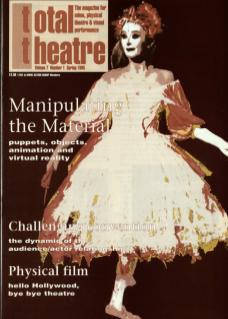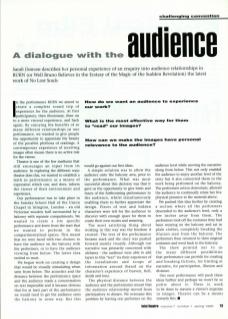In the performance Burn we aimed to create a complete round trip of experience for the audience. At first participatory, then illusionary, then on to a more visceral experience, and back again. By enjoying the benefits of so many different relationships in one performance, we wanted to give people the opportunity to appreciate the beauty of the possible plethora of readings. A contemporary experience of receiving images often means there is no active role for the viewer.
Theatre is one of the few mediums that still encourages an input from its audience. In exploring the different ways theatre does this, we wanted to establish a faith in performance as a means of expression which can, and does, inform the viewer of their environment and experience.
Our performance was to take place in the Sunday School Hall of the Union Chapel in Islington, London – an old Victorian wooden hall surrounded by a balcony with separate compartments. We wanted to create a site-specific performance and knew from the start that we wanted to perform in the compartmentalised spaces. This meant that we were faced with two choices: to have the audience on the balcony with the performers, or to have the audience viewing from below. The latter idea excited us most.
We began work on creating a design that would be visually stimulating when seen from below. The acoustics and the distance between the performance space and the audience made a concentration on text impossible and it became obvious that for at least part of the performance we would need to get the audience onto the balcony in some way. But this would go against our first ideas.
A simple solution was to allow the audience onto the balcony area, prior to the performance. What was most successful about this decision was that it gave us the opportunity to give hints and traces of the forthcoming performance to the audience, whilst simultaneously enabling them to further appreciate the design. Pieces of text and hidden characters were left for the audience to discover with enough space for them to create their own stories and meaning.
The most satisfying thing about working in this way was the freedom it created. The text of the performance became stark and the story was pushed forward mainly visually. Although our narrative was primarily concerned with alchemy – the audience were able to add layers to this ‘text’ via their experience of the installations and scraps of information around (based on the character's experience of heaven, hell, death and loss).
The physical distance between the audience and the performance meant that the audience relationship moved from participatory to distant. We overcame this problem by leaving one performer on the audience level while moving the narrative along from below. This not only enabled the audience to enjoy another level of the story but it also connected them to the work being performed on the balcony. The performer’s action downstairs allowed the audience to continually relate her live physical presence to the material above.
We pushed this idea further by creating a section where all the performers descended to the audience's level, only a few inches away from them. The performers took off the costumes they had been wearing on the balcony and sat in plain clothes, completely breaking the illusion seen from the balcony. The performers then returned to their original costumes and went back to the balcony.
The show pointed out to us the many different possibilities that performance can provide for creating and breaking fictions, for hinting at narrative, for participation, illusion and distance.
Our next performance will push these ideas further and perhaps we won't be so polite about it. There is work to be done to reassess a viewer's response to images. Theatre can be a means towards this.

